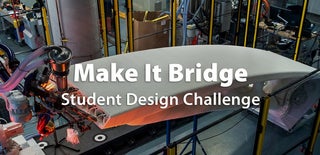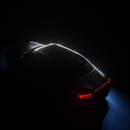Introduction: Wave Bridge (Wheelchair Accessible)
About me: Hello, I am a 15-year-old, soon to be a Junior (high school) in Texas. I enjoy both architecture and engineering and have taken multiple competitions in my previous years.
Defining the problem: Most pedestrian bridges seen in beach/river areas are unoriginal and do not have much decoration. This thought offered me the idea to not only make a pedestrian bridge that includes wheelchair accessibility but also to introduce more natural elements and design to my pedestrian bridge idea.
Bridge Description: Since this pedestrian bridge is located near a beach at a river, I gave the pedestrian bridge a 'wave' look to the left and right facades, and placed a surfboard as decoration being held up by the wood columns. To bring natural light, I decided to make an entire greenhouse of just glass, and benches betwixt the central portion of the bridge. Since there is an enclosed greenhouse, I encumbered a space for planted trees to allow for more natural elements to enter the bridge.
Assigning goals:
-Ensure the safety of pedestrians crossing the bridge, while incorporating a sense of comfortable natural design that brings people closer.
-Encapsulate availability for every pedestrian crossing the bridge, including wheelchair accessibility.
-Using strong and stable materials to allow for the bridge to be structurally sound like concrete, wood, steel, and metal.
-Creating a greenhouse structure that allows natural light to enter through the bridge
-Make spaces for seating within the bridge so pedestrians can enjoy the scenery from either side of the river/beach.
Most Interesting features on the Wave Bridge:
-Wheelchair Ramps on either side of the bridge to allow access to every individual
-Greenhouse structure within the interior of the Wave Bridge to allow for natural lighting
Supplies
I used Autodesk Maya for the entirety of the project.
Step 1: Inspiration
Before I started sketching out my pedestrian bridge, I wanted to see if there were any other examples of natural design and decoration in pedestrian bridges. I then performed a decision matrix on which photos I wanted to use for inspiration and brought the selection down to three images. I then utilized these three images to design a natural bridge design. The only issue with each of these inspiration images was that they were all renders, and were not seen in real life which proves my idea of creating a natural bridge that is not only structural but simple to design in terms of construction.
Step 2: Sketching
For this sketch, I ensured that I utilized the three images in the step before, took the natural elements from the inspiration photos like the curves, and the decorative elements, and placed them within my goal of encapsulating a beach town design of the pedestrian bridge. After this thought, I went to research the types of elements that are typically seen on beaches. The first thing that came up was docks which usually include wood columns, so I added those at the base of the bridge in the sketch. The other thing that came up was surfing boards, so I placed the surfboard design on the wood columns. Another thing that is usually seen on beaches is waves, so I placed the overall wave design on the facades so it represents a natural design.
Step 3: Modelling in Maya
For the modeling aspect of the Wave bridge, I especially had to make sure that every aspect of the sketch was accurate to the modeled version since I wanted the design to remain the same. I first started with modeling the overall mountain, then made split openings for the river area. After that, I crafted the river and the sandy bed that goes underneath the water. After that, I designed and constructed the shell of the bridge, then added the minute details like the wheelchair access ramp, stairs, benches, and greenhouse windows. After every other detail within the bridge was complete, I started to make the trees in the surrounding environment AND make the planted trees separate and sized smaller within the bridge.
Step 4: Lighting/texturing
For the lighting, I had to ensure that they followed the restrictions within the Arnold render. The lightings I used were photometric lights, area lights, and sky dome lighting for the skybox itself, as it brings more realism. For the texturing aspect, I utilized as many textures as possible for each of the objects modeled within the scenes. However, I ensured that I utilized Standard Surface materials to bring more realism to the textures, They were mostly used on the water, and the textures themselves utilized specular and diffusion for the Arnold renderer.
Step 5: Finished Product
After utilizing the Arnold renderer within Maya I increased the camera exposure by 1.5 in order to make the lighting pop out more, increased the shading capacity, and saved the images. Thank you for viewing my project!

Participated in the
Make It Bridge











